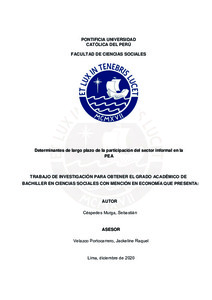| dc.contributor.advisor | Velazco Portocarrero, Jackeline Raquel | |
| dc.contributor.author | Céspedes Murga, Sebastián | |
| dc.date.accessioned | 2022-09-22T01:17:37Z | |
| dc.date.available | 2022-09-22T01:17:37Z | |
| dc.date.created | 2020 | |
| dc.date.issued | 2022-09-21 | |
| dc.identifier.uri | http://hdl.handle.net/20.500.12404/23366 | |
| dc.description.abstract | The high participation of the informal sector in the economically active
population (EAP) represents a key problem for the Peruvian economy,
particularly in its condition as a developing country. In this sense, the aim of this
thesis is to identify the long-term determinants of informal sector participation in
the EAP. This study is related to the so-called “dual vision of informality”, to which
LaPorta and Shleifer (2014) have recently contributed. Our hypothesis states that
when both the per-capita capital stock and productivity rates of growth slow down
below the population rate of growth, participation of the informal sector in the EAP
tends to grow. That is to say, in the long-term participation of the informal sector
in the EAP is determined by this set of variables. This hypothesis relies on an
assumption made on the basis of Keynesian growth theory, by Thirlwall (2007)
and Jiménez (2011), which consists of the fact that developing economies exhibit
a warranted rate of growth which is inferior to its natural rate of growth. This
causes a long-term increasing unemployment growth pattern. In other words, we
hold that a high participation of the informal sector in the EAP is a byproduct of
this growth pattern. In order to test this hypothesis a basic cointegration model
will be applied. This will allow us to test the existence of long-term relationships
between the rate of growth of informal sector participation in the EAP and the
productivity, per-capita capital stock and population rates of growth with data from
Peru between 1950 and 2015. A preliminary data analysis shows that, between
the decades of the 1970s and 1990s, both productivity and per-capita growth did
slow down below population growth, which could explain a positive growth in
informal sector participation in the EAP during those years. | es_ES |
| dc.language.iso | spa | es_ES |
| dc.publisher | Pontificia Universidad Católica del Perú | es_ES |
| dc.rights | info:eu-repo/semantics/openAccess | es_ES |
| dc.rights.uri | http://creativecommons.org/licenses/by/2.5/pe/ | * |
| dc.subject | Población activa--Perú | es_ES |
| dc.subject | Sector informal--Perú | es_ES |
| dc.title | Determinantes de largo plazo de la participación del sector informal en la PEA | es_ES |
| dc.type | info:eu-repo/semantics/bachelorThesis | es_ES |
| thesis.degree.name | Bachiller en Ciencias Sociales con mención en Economía | es_ES |
| thesis.degree.level | Bachillerato | es_ES |
| thesis.degree.grantor | Pontificia Universidad Católica del Perú. Facultad de Ciencias Sociales | es_ES |
| thesis.degree.discipline | Ciencias Sociales con mención en Economía | es_ES |
| renati.advisor.dni | 07945434 | |
| renati.advisor.orcid | https://orcid.org/0000-0001-5554-2198 | es_ES |
| renati.author.dni | 71918309 | |
| renati.discipline | 311016 | es_ES |
| renati.level | https://purl.org/pe-repo/renati/level#bachiller | es_ES |
| renati.type | https://purl.org/pe-repo/renati/type#trabajoDeInvestigacion | es_ES |
| dc.publisher.country | PE | es_ES |
| dc.subject.ocde | https://purl.org/pe-repo/ocde/ford#5.02.01 | es_ES |






